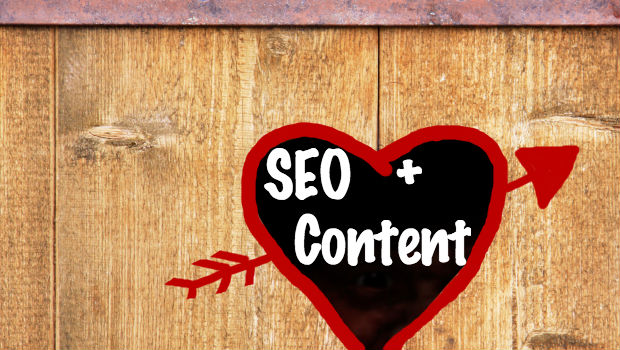
6 Ways to Keep SEO and Content Sittin’ in a Tree, K-I-S-S-I-N-G
Think back to high school and your first puppy love experience. If you were a rebel, you might have written your name and your new love interest on the bathroom wall with a big heart surrounding the two names. Well, in the bathroom stall of Small Biz High School, you will surely find SEO <3’s Content. SEO has always had the hots for content, but never had the courage to make it known to the world. After a slew of Google updates that attacked poor, low quality content, SEO and content are now the cutest couple on the block.
Here are 6 great ways to keep your SEO and content k-i-s-s-i-n-g in the tree:
Quality Over Quantity
The landscape of SEO has drastically changed in the past few years, and the days of building thousands or millions of links are long gone. The same goes for your relationship between SEO and content. Having low quality blog posts or articles will not only hurt your website in Google’s and Bing’s eyes, but your readers will notice the lack of substantial content. If your readers don’t find value in your content, they won’t return, and more than likely won’t share your posts on their social networks.
Diversity
“Diversity” is the SEO buzzword of 2013. Keep your anchor text, landing page and links diverse. We know you may have the urge to only link to your top selling item on your home page, but resist this temptation. We now know that Google doesn’t like that and won’t rank your site as high if you have an artificial or over-optimized link profile. A link profile consists of the links from other sites that are pointing to your site. Search engines want to see a natural link profile. Here is a great way to double check and make sure you are linking naturally in your posts: If you mention a cool new marketing resources blog, like Skadeedle, you would expect to be linked directly to that site. That’s how you want to link to your own site in your blog posts. This is also known as internal linking. If your internal linking is smooth and easy to read, and the content is valuable, readers should enjoy it and share your content.
No Minimums
Setting up minimums for word count and/or keyword requirements on your blog or blog posts leads to unnatural looking posts and not to mention hard-to-understand posts. If you own an online coffee mug store called Chipper’s Coffee Mugs, and every 5th word on your site is “Chipper’s Coffee Mugs,” it’s difficult to actually gather any substantial information. If your post is too short, readers might suspect that it lacks any value. A post that is too long runs the risk of losing the reader’s attention. Over time, you’ll find that word count sweet spot that your readers enjoy.
Google Authorship
You have great content that’s relevant and high quality, and you want to rank high in Google. How do you get the two together? Google Authorship is the answer. Authorship has been buzzing in the SEO community for the past year or so. With cool SEO plug-ins (available on self-hosted blogs) like Yoast, setting up your Google Authorship is easy. We could spend a whole post just explaining why Authorship is so important, but Mike Arnesen from SwellPath did a top-notch job, so check out why author rich snippets are important.
Small Stuff You Need to Sweat and Not Forget
Once you finish that masterpiece of a blog post, don’t set it and forget it! Make sure to remember these small details that’ll help your content get all the juicy SEO love it can:
Meta Data
This is getting into some semi-technical SEO stuff, but don’t get scared and stop because that Yoast plug-in makes it so very easy for you. Meta data is what’s displayed when your site is served in the SERP. A SERP is the search engine results page, or in layman’s terms, the Google or Bing results page. The meta title is the title of the page and it should be a maximum of 70 characters. The meta description is a preview of the post that’s also served up in the SERP. Be sure to limit your meta description to 160 characters for optimal results.
Images count too!
Don’t just paste your images into your blog post without first adding some nice SEO value to it. Images need some love too! Make sure to include the keyword in the file name of the image. So change “photo1472368.jpg” to “chipscoffeemuglogo.jpg” to make your images complement your amazing content. Remember the Google Bot doesn’t have eyeballs, so you have to tell it what your images are. That is where alt text comes in. You want to make sure to include some descriptive alt text on your images so the Google Bot knows what your image is about. Before you go crazy on your images, don’t keyword stuff your alt tags or file names. Your photo called “coffeemugsmugscoffee_coffee_mugsmugsmugs.jpg” will surely get the Google Bot’s attention and not in a good way.
If you’ve been thinking of starting, ramping up or enhancing your content game, these six tips will not only help your content get all the SEO love it can, but will help you avoid being negatively impacted by any Google updates like the Google Skunk. Remember, good SEO takes time and implementing these changes won’t get your to page to the first page over night. Like Billy Joel said, “keep the faith” and these SEO tips will help in the long run.
Do you have a success story from using Google Authorship or any of these other tips? We’d love to hear about it!
© 2013 – 2018, Contributing Author. All rights reserved.




